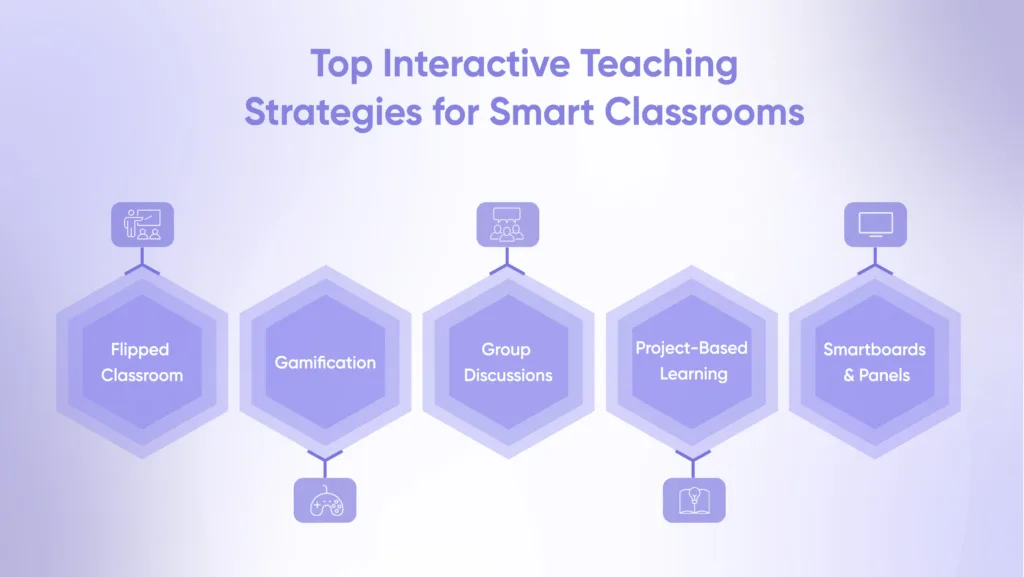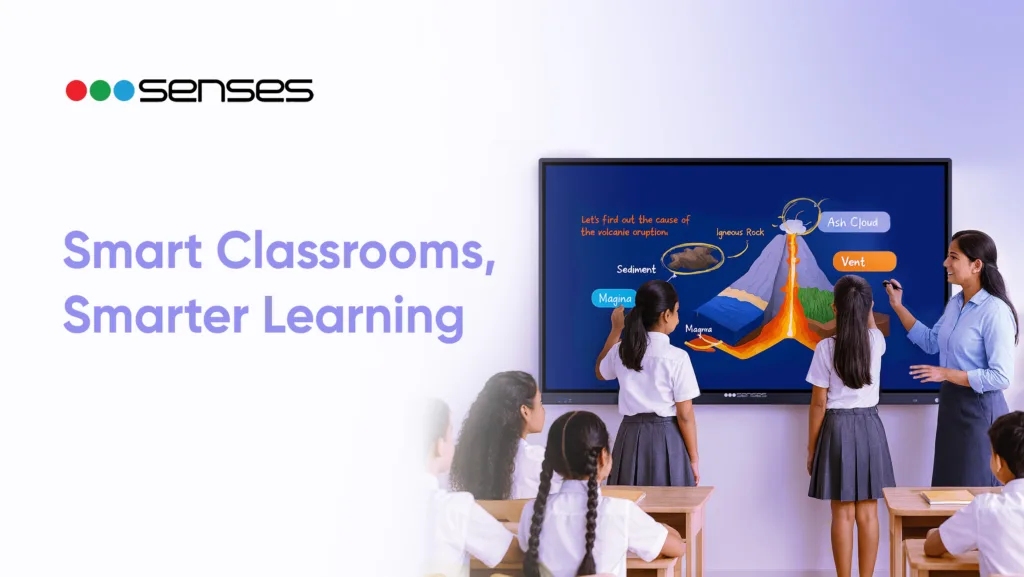Interactive teaching methods are approaches that actively involve students in the learning process rather than making them passive listeners. Today’s education focuses on student participation, collaboration, and critical thinking instead of just memorising.
Innovative methods such as flipped classrooms, gamification, and project-based learning promote better educational outcomes. Additionally, Senses Electronics modernises the education system with interactive flat panels and AI-driven solutions, facilitating the adoption of these methods.
This blog will explore the definition, benefits, common practices, and future of interactive teaching strategies that foster engaging learning environments.
Key Takeaways:
- Interactive teaching methods encourage students to engage in effective learning.
- Classrooms featuring technology used for instruction to build engagement support improved overall learning performance.
- Senses Electronics has created solutions for teachers and schools to successfully incorporate interactive teaching and learning methods, easily using something the students love and engage with.
What is an Interactive Teaching Method?
Different from the methods of teaching where the instructor instructs and the learners listen, an interactive method of teaching subsequently includes the notion of two-way communication by focusing on spoken interaction.
Learners are invited and provided with opportunities to ask questions, express opinions, work through problem-solving, and engage in real-time, active learning opportunities.
Why This Matters in 2025
Interactive methods of teaching matter in the year 2025 because learners in today’s society expect learning experiences to be engaging while also using technology.
For example, with the invention of smart boards and other interactive panels, instructors are now able to present a learning experience that is dynamic and engaging, making learning more enjoyable as well as effective.

Benefits of Interactive Teaching Strategies
Using interactive teaching methods makes instruction better and has a positive impact on students’ success.
1. Encourages Students’ Engagement
Interactive methods encourage active student engagement in learning rather than passive information delivery. Simple tools like quizzes or polls can enhance the lesson’s atmosphere and introduce elements of enjoyment and risk.
2. Promotes Cooperation and Interaction
Group discussions and peer-to-peer learning are examples of collaborative teaching strategies that help students develop their interpersonal skills and create a sense of community among their peers.
3. Recognizes Different Learning Styles
Every learner learns distinct ways. Some will learn better if presented with a diagram or a video, and still others will want a hands-on experience.
4. Builds Critical Thinking and Creativity
Having students work through case studies in their real life enhances problem-solving ability and provides a platform for students to express creativity in line with course learning outcomes.
5. Makes Learning Fun
Gamifying the class produces more enjoyment in learning. Individual students show an increase in attendance and a willingness to engage in their own educational process further outside the classroom.

Key Interactive Teaching Methods for Smart Classrooms
Teachers can use a variety of innovative teaching strategies to enhance students’ learning outcomes.
| Teaching Methods | Description |
| Flipped Classroom | Students will learn theoretical content at home through videos or readings and then discuss the topic in class, working on problems with an active-learning strategy for deeper understanding. |
| Gamification & Quizzes | Gamification uses play elements (points, badges, and/or leaderboards) to make learning fun and competitive. |
| Group Discussion & Peer Learning | Collaborative teaching approaches allow students to brainstorm, argue, and learn with each other. Involves some degree of reprieve for increased student confidence and communication. |
| Role Plays and Simulations | Practical methods allow students real-world experience. In a management class, the students could conduct a business meeting, and in a law class, the students could role-play a courtroom. |
| Project-Based Learning Method | Students will take part in long-term projects that often solve real-world issues; this methodology allows for collaborative units, promotes innovative thinking, and encourages the students to work towards a final outcome while marrying theory with practice. |
| Use of SmartBoards & Interactive Panels | Interactive technology, like the SenseTeam 4K smartboard, enables classroom leaders to engage students in immersive lessons that incorporate digital media for annotation, multimedia, and real-time quizzes. |
Innovative Teaching Methods in 2025
Technology has made it possible to implement creative teaching strategies that go beyond conventional wisdom.
1. AI-Powered Learning Tools
AI can provide students with a personalized learning path based upon their strengths and weaknesses.
| Example: If a student is struggling with algebra but does very well in geometry, an AI application can assign additional algebra work without the repetition in geometry assignments. |
2. Augmented & Virtual Reality in Classrooms
Students can take virtual field trips, complete science lab experiments and explore historical sites all without leaving the classroom with AR and VR experiences.
| Example: In history, students could wear VR headsets that allow them to “walk through” the ancient pyramids of Egypt and look at the architecture as if they were there. |
3. Online Platforms for Collaboration
Collaborative learning can be facilitated through file sharing, messaging, and real-time online projects through apps like Google Classroom or Microsoft Teams.
| Example: A group of students works on a science project, uploading all their research to Google Docs so they can all edit it at the same time and get instant feedback from their teacher. |
4. Data-Driven Instructional Practices
Analytics may give teachers insight to adjust their instructional practices in their lesson plans so that all students receive instructional support if needed.
| Example: The teacher can create an interactive performance task to remedy misconceptions before going further with the next lesson if half of the class has problems with the quiz on fractions. |
Role of Smart Classrooms in Interactive Teaching
Smart classrooms lay the groundwork for engagement and interaction-based teaching methods.
1. How Smart Classrooms Function
A smart classroom uses technology-oriented interactive teaching methods in the form of smart boards, digital projectors, cameras, and microphones to make lessons more engaging, interactive, and more easily accessible.
2. Why Smart Classrooms Change the Teaching Experience
When lessons are interactive, there is a higher level of engagement, retention of learning, and improved learning outcomes. Students generally connect more meaningfully with multimedia lessons than passive lectures.
Senses Electronics and Smart Classroom Solutions
Senses Electronics provides the best tools to keep teachers and learning interactive.
- Interactive Panels With 4K Display: Incredible visuals allow students to focus on the content you are teaching. As a teacher, you can easily write directly on the screen to easily illustrate your points and explanations.
- AI-Integrated Classroom Tools: Smart AI cameras and management systems from Senses Electronics make hybrid learning seamless and easy to manage.
- Why schools choose Senses Electronics: With dependability, ease of use, and pricing, schools and institutions across India choose Senses Electronics to build smart classrooms.
👉Get the latest equipment for interactive panels from Senses Electronics to future-proof your teaching!
Future of Interactive Teaching Methods
The next decade of education will be increasingly reliant on technology-enabled, student-centred methods.
- We will see a rise in blended and hybrid learning, where education consists of both online and in-person components and adapts to suit the needs of students, centres of education, and school systems.
- We will have personalised, AI-driven opportunities for classroom education, where students can access content in an individualised way, improving outcomes for students.
The role of interactive smartboards and interactive teaching panels will increase as commonplace across the globe in all educational settings.

Conclusion
Interactive teaching methods are transforming education by fostering engagement and creativity through approaches like flipped classrooms, gamification, and project-based learning.
With the rise of smart classrooms, equipped with digital boards and AI tools, teaching is becoming more effective. To fully embrace 21st-century strategies, schools need the right technology partner.
👉 Senses Electronics provides smart classroom technologies, including 4K interactive panels and AI-powered teaching tools, to create engaging and effective learning environments.
FAQs
It is an approach where students have a role in their learning process; students learn through talk, activities, tasks, and investigation.
Some methods of interactive teaching include the flipped classroom, gamification, project-based learning, group discussions, and role play.
Smart classrooms offer resources like electronic digital boards and AI solutions and help to make a lesson more interactive and engaging.
Senses Electronics can provide interactive panels, AI tools, and equitable costs in smart classroom solutions for modern teaching.

